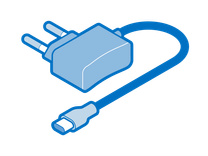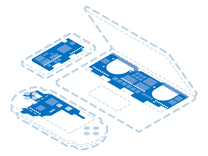Introduction
Is your Dell Inspiron not turning on? This problem page will review several common occurrences regarding your Dell Inspiron not powering on or booting into Windows. Either software or hardware causes can cause the problem, so read on to determine the right solution for you!
The Basics
These first few steps may seem trivial; however, it is easy to forget the troubleshooting basics during times of frustration. Before you start any significant repairs to your device, please check the following:
- Check Power Source: Ensure your laptop's power source functions correctly. Connect another device or swap to another outlet to verify.
- Verify the Battery is Connected: If your Dell Laptop has a removable battery, ensure it is seated correctly and secured. If it has a locking switch, be sure it is in the locked position.
- Remove all peripherals. This applies to anything attached to your laptop—flash drives, USB hubs, display cables, dongles, literally anything other than the charger.
- Listen for any Beep Codes: Beep codes and lights diagnose computer booting issues. Document these beeps and light flashes and search Dell's beep code support page for your exact Dell laptop model to find the associated beep codes.
- With the laptop powered off, press the power button and listen for any beeping sounds or flashing lights on the side of the laptop.
- Typically, the Caps Lock LED or the charge light indicator will blink if a code is given.
Causes
A faulty power supply or Dell Inspiron Series Power Adapters can prevent your laptop from receiving the electricity to turn on.
- Inspect the power cable and connector for any visible damage, fraying, or loose connections. If you have a charger with a barrel connector, be sure the pin inside the barrel isn’t bent or damaged.
- Try a new or known-good charger. Alternatively, use your charger with another compatible Dell laptop. Does a different charger work? It's time for a new one. If yours works with another laptop, tough luck, but it won't be that easy.
- Many newer Dell Inspiron laptops will charge via USB-C and their dedicated DC jack. Even a low-wattage charger could provoke different behavior. If this works, a new charger is in order.
- Not all USB-C ports will support charging. Some Dell laptops restrict one USB-C or Thunderbolt port to function as the designated charging port, often marked by an icon (e.g., ⚡ or a power plug logo).
- If a USB-C charger works but the original charger does not, this could indicate a faulty port rather than the charger.

Find compatible replacement parts for your Dell Inspiron. All parts and fix kits are backed by the iFixit Quality Guarantee.
If a regular force reset does not work, a hard reset is necessary to drain the capacitors fully. To do this:
- Remove all peripherals, the charger, and the battery. Once everything is removed, hold the power button down for 60 seconds. This makes the computer attempt to power on and drain the capacitors, which results in the built-up static charge.
- If your laptop does not have an external battery, you can find a replacement guide specific to your model on the Dell Laptop repair page.
- Sometimes, you will need to unplug the BIOS battery (CMOS battery) and drain all power from the laptop.
Corrupted BIOS or other device firmware can prevent the laptop from completing power-on tests and may only show minimal power signs.
- Unlike software written for internal storage, BIOS and other firmware are written directly into the chips themselves. If these directions are missing or damaged, the device might be unable to power up.
- Attempt to access the BIOS by pressing F2 or F12 when you see the Dell splash logo on the screen during startup. You may need to rapidly press the key, as the window for key presses is narrow.
- If possible, update the BIOS to the latest version using Dell's official support website or software. There may even be a utility to update right in BIOS. There may also be a USB recovery option.
If the laptop still doesn't turn on after resetting or updating the BIOS, or if you cannot access the bios, the issue is likely more severe damage to the display or one of the major components.
Suppose your laptop seems to be functioning normally, but the screen isn't displaying anything (keyboard backlights turn on, you can hear fans running, any power lights or battery status lights turn on and function as they should). Problems with the display or graphics hardware can give the impression that the laptop is not turning on. Use the following steps below to troubleshoot any display issues.
- Plug your computer into a separate monitor to test if your computer is outputting anything.
- Try a software fix by restarting the video driver. This works in Windows 7 and up.
- To restart the video drivers, use this keyboard shortcut: Windows Key + Ctrl (Control) + Shift + B.
Navigate to the page for your specific model of Dell Inspiron to find a screen guide that works for your device.
A faulty battery may be preventing your laptop from receiving the power necessary to power on. If you've already addressed all possible software issues and your device still shows zero signs of life, a battery replacement should get your laptop back on its feet.
- Navigate to the page for your model of Dell Laptop to find a battery guide that works for you. If you can't find your particular model, removing the screws on the back, disconnecting the battery connector, and unscrewing the battery screws should do the trick.
Suppose your laptop seems to be functioning normally, but the screen isn't displaying anything (keyboard backlights turn on, you can hear fans running, any power lights or battery status lights turn on and function as they should). In that case, you'll likely want to replace the screen.
- Navigate to the page for your model of Dell Inspiron to find a screen guide that works for you. If you can't find your particular model, following a guide for a similar model may still help you with the process.
- While disassembling the laptop, pay close attention to the display cable(s) and any associated connectors. If you notice anything amiss with the cables or connectors (fraying/cut cables, unseated connections, etc.), replacing damaged cables or reseating connections may solve the problem without completely replacing the display.
Malfunctioning hardware components, such as motherboard or RAM, can prevent your laptop from powering properly.
- Perform a visual inspection of the laptop's internal components to check for any visible damage or loose connections.
- Reseat the RAM modules and other removable components to ensure they are correctly connected to the motherboard.
- If you suspect a specific hardware component is causing the issue, consult Dell's official support documentation and, if necessary, replace any damaged components.
- Dell Inspiron Series Motherboards and an associated guide for your model of Dell Inspiron laptop.

Find compatible replacement parts for your Dell Inspiron. All parts and fix kits are backed by the iFixit Quality Guarantee.

